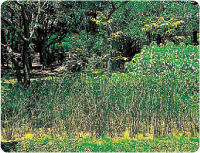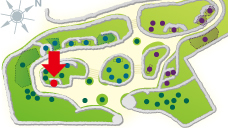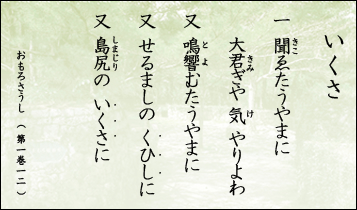Traditional Okinawa Village and Omoro Arboretum
- HOME
- Facilities
- Native Okinawan Village and Omoro Botanical Garden
- Botanical Garden exploring map
- Juncus effusus L. var. decipens Buchen
Juncus effusus L. var. decipens Buchen
General description

| Omoro name | Ikusa |
|---|---|
| Japanese name | I |
| Family name | Juncaceae |
| Okinawan name | Bihgu, Ohtuhjin |

Location within the park

Characteristics
Juncus effusus L. var. decipens Buchen is said to have originated in the warm regions of the northern hemisphere. It naturally grows in bogs of Southeast Asia, North America and various parts of Japan, and is cultivated in paddy fields in Japan, China and Korea. It is said that the cultivation of Juncus effusus L. var. decipens Buchen spread in Japan from the Edo period and on when ordinary people began to use tatami mats in their daily lives. The underground stem grows sideways, and the stem above ground grows to be about 10 to 28 inches tall. Its flower is a spikelet formed by inflorescence of about 0.08 inches clustered together on the tip of the stem. The stem has a cylindrical cross-section surface, and is easy to distinguish from the Cyperus monophyllus which has a trigonal prismatic cross-section surface.
Utilization
【culm】 : tatami facing, mat, mat with floral pattern, shopping basket, braided hat, sandals, wick
【leaf, culm, root】 : Used for medicinal purposes such as a cure for fever, swelling and stomach disorder
【scent】 : relaxation effect, antimicrobial effect
Best Time To See Calendar

Omorosaushi (12 of Volume 1) Ikusa

Meaning of the song
Give spiritual power of the lord (goddess)
To this well-known mountain
To this echoing mountain
To this mock wisteria of Seshirumashi (name of place)
To the Juncus effusus L. var. decipens Buchen of Shimajiri District








